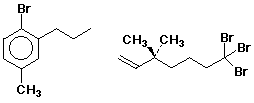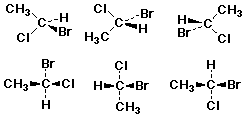

Professor Carl C. Wamser

Chapter 6 - Stereochemistry
Stereochemistry
- chemistry in three dimensions
- includes both structure and reactivity effects
Enantiomers
- mirror-image stereoisomers
- like left and right hands
(see page 172 in your text)
- observed when a carbon atom has four different groups attached to
it
CHXYZ or CX1X2X3X4
Enantiomer Examples




Chirality
- property of having "handedness"
(different from its mirror image)
- a molecule with any element of symmetry (e.g., a mirror plane) must
be achiral
Stereogenic Centers
- chiral centers or stereocenters
- a molecule with a stereogenic center (e.g., CX1X2X3X4) will be chiral
- a stereogenic center cannot be:
sp- or sp2-hybridized (must be sp3)
an atom with 2 identical substituents (e.g., any -CH2- group)
Identifying Chiral Molecules
- achiral

- chiral

Properties of Enantiomers
- enantiomers have identical physical and chemical properties,
EXCEPT they
- interact with another chiral molecule differently
(like trying on left- or right-handed gloves - left and right hands react
differently)
- rotate the plane of plane-polarized light by equal amounts but in
opposite directions
Optical Activity
- chiral compounds rotate the plane of plane-polarized light
- rotation measured in degrees
clockwise (dextrorotatory or +) or
counterclockwise (levorotatory or -)
- polarimeter - instrument for measuring optical activity
Specific Rotation
- standard amount of optical rotation by 1 g/mL of compound
in a standard 1 decimeter (10 cm) cell
- [a] = a / l C
- where [a] is specific rotation
a = observed rotation in degrees
l = path length in dm
C = concentration in g/mL
Absolute Configuration
- nomenclature method for designating the specific arrangement of groups
about a stereogenic center
- differentiates between enantiomers
- uses the same sequence rules for establishing priority of groups as
was used for E and Z
R and S Designations
- assign priorities 1-4 (or a-d) to the four different groups on the
stereogenic center
- align the lowest priority group (4 or d) behind the stereogenic carbon
- if the direction of a-b-c is clockwise, it is R
- if a-b-c is counterclockwise, it is S
Right- and Left-Hand Views
- textbook analogy - steering wheel
- alternative analogy - your hands
assign priorities to your fingers in order of height
a = middle finger, b = pointer finger, c = thumb, d = wrist
R - this works for your right hand
S - this works for your left hand
Drawing 3-D Structures
- practice with models
- dotted-line & wedge

Multiple Stereogenic Centers
- compounds with more than 2 stereocenters have more than 2 stereoisomers
e.g., 2-bromo-3-chlorobutane
(2R,3R) and (2S,3S) are enantiomers
(2R,3S) and (2S,3R) are enantiomers
- in general, n stereocenters give 2^n stereoisomers
Diastereomers
- stereoisomers that are not enantiomers
e.g., (2R,3R) and (2R,3S)
(not mirror images, but not the same either)
- diastereomers may have different chemical and physical properties
Meso Compounds
- compounds with stereogenic centers but which are not chiral
e.g., (2R,3S)-2,3-dibromobutane
(same as its mirror image)

Identifying Meso Compounds
- mirror plane of symmetry
- one stereocenter is the mirror image of the other
- cis-1,2-disubstituted cycloalkanes are meso if the two substituents
are identical

Racemic Mixtures
- an equal mix of both enantiomers (also called a racemate)
- a common form in the laboratory (but not in nature)
- optical resolution - separating enantiomers from a mix(typically
difficult)
Isomerism - Summary
- isomers - same molecular formula (same collection of atoms used)
- constitutional isomers -differ in the connections between atoms
different carbon skeletons
different functional groups
different locations of a functional group
Stereoisomers - Summary
- stereoisomers - same connections but in different 3D arrangement
- enantiomers - mirror-image stereoisomers
- diastereomers - non-mirror-image stereoisomers:
cis-trans diastereomers
other diastereomers
Stereochemistry in Reactions
- achiral reactants always give optically inactive products
- if chiral products are formed, they will be racemic
e.g., 1-butene + HBr --> 2-bromobutane (racemic)
intermediate 2-butyl cation can add Br- to either side equally likely
- but chiral reactants can give chiral products (the usual case in nature)
Stereochemistryt of Alkene Additions
- anti addition (Br2)
cyclic compounds --> trans-1,2-dibromo product (racemic)
- syn addition (KMnO4)
cyclic compounds --> cis-1,2-diol product (meso)
Stereochemistry of Alkene Additions
- products from acyclic alkenes are more difficult to trace:
cis-2-butene + KMnO4 (syn) --> 2,3-butanediol (meso - R,S)
trans-2-butene + KMnO4 (syn) --> 2,3-butanediol (racemic - R,R &
S,S)
trans-2-butene + Br2 (anti) --> 2,3-dibromobutane (meso - R,S)
cis-2-butene + Br2 (anti) --> 2,3-dibromobutane (racemic - R,R &
S,S)






